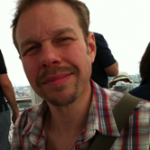
Steve Brown
Research Fellow at the Royal College of Art
steveroystonbrown@hotmail.com
www.steveroystonbrown.com
Biography
Steve Brown began his career as a commercial textile printer in 1984. Returning to education in 1998 he studied for a BA at Plymouth University and an MA in the Royal College of Art’s Ceramics and Glass department, returning there in 2006 to undertake a PhD: ‘The Physicality of Print’. Brown exhibits internationally, makes work to commission and has taught at the RCA since 2003. He is currently also working on a joint research project between the RCA and the V&A museum, using new 3D scanning and printing technologies on a restoration project with Meissen porcelain.
Academic Paper
Material Matrixes: Building on a history of improvisational developments in print technology
The etymology of the word ‘matrix’ links printmaking with moulding, two processes that are at the heart of my own work. Through a number of research projects I have adopted a hybrid approach to practice that focuses on the integration of print and form in ceramics and glass materials, often through developing unique in-mould decorating systems.
Printmaking within the applied arts has a long history of interdisciplinary practice, forging relationships between seemingly disparate materials and processes. For this paper I would like to explore the matrix as a nexus, which has determined hybrid practice within the applied arts.
In his 1904 publication ‘Ornament and its Application’ the Designer Lewis Day suggests the removal of preconceived boundaries thinking instead through ‘Allied Processes’. Considering the print stencil alike to fretted woodwork and inlay he re-titles this new field as ‘À Jour’, describing an aperture or to allow light though, and we can update this to include new technologies such as laser and water-jet cutting. This allows us to think more openly about the cross-fertilization of process principles.
Thirty years later the printmaker and historian Henri Focillon wrote ‘Vie des Formes’ in which he rejects a chronological approach to history in favour of discussing the development of creative practice as in constant flux, a fluid and dynamic ever evolving life ‘always becoming…and tending towards realization’.
In the recent book, ‘The Gutenberg Revolution’, John Man states that ‘Ideas seldom jump into the mind from nowhere.’ That they ‘are seeded in frameworks of previous growths and need those same frameworks to flourish.’ This frames Gutenberg’s innovation in printmaking as made possible by existing materials and technology.
The combined thinking behind the writers above, offer an alternative understanding of creative printmaking practice. By using this critical and historical framework, and other practice based examples, I aim to deconstruct material and process boundaries in order to describe a new way of considering the creative life of applied art printmaking practice that I have explored through my own practice based research into ‘casting print’.
